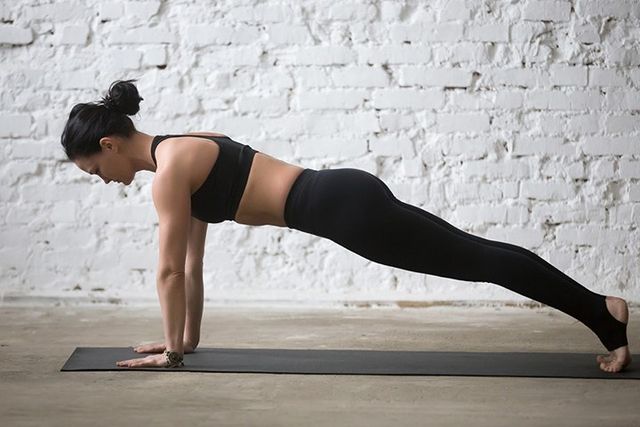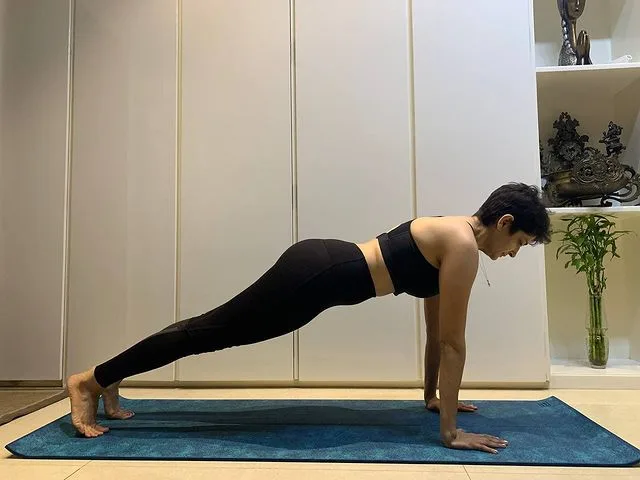Phalakasana, also known as Kumbhakasana or High Plank Pose, strengthens and tones the core, abdominal, wrists, shoulders, upper arms, forearms, hamstrings, quadriceps, and calves muscles.
Experts believe that regular practice of this yoga pose is a strength training pose that challenges the entire body and mind, helping to improve your strength, physique, and mood.
This is a comprehensive strengthening posture by engaging your shoulder muscles, abdominal core muscles, quads, trapezius, rhomboids, triceps, lats, glutes and hamstrings.
The pose helps in stability, builds focus, increases muscle definition, and prepares your body for balance with the other hand. The pose also strengthens the muscles around the spine, giving you better posture.
Information
| Known as: | Phalakasana, High Plank Pose, Plank Pose, Kumbhakasana, Santolasana, Utthita Chaturanga Dandasana |
| Sanskrit name: | फलकासन |
| IAST: | Phalakāsana |
| Pronunciation: | fal-ack-AHS-anna |
| Level: | Beginner |
| Type: | Arm balance, strength |
| Focus: | Entire body, core, abs, spine, arm, back, leg |
| Total time: | 30 to 60 seconds plus |
| Drishti: | Down and slightly forward |
| Chakra: | Manipura Chakra |
| Indications: | Respiratory system, insomnia, migraine, irritable symptoms, obliques, transverse abdominus, rectus abdominus, sciatica symptoms, metabolism, glutes, tibialis anterior, rhomboids, deltoid, biceps, triceps, backaches, parasympathetic nervous system response, hormones such as thyroxine, menopause |
| Counterposes: | Child’s Pose (Balasana), Sphinx Pose (Salamba Bhujangasana), Adho Mukha Svanasana (Downward-Facing Dog Pose), Bhujangasana (Cobra Pose), Upward Facing Dog Pose (Urdhva Mukha Svanasana), Bharmanasana (Table Top Pose), Tadasana (Mountain Pose) |
| Preparatory poses: | Uttanasana (Standing Forward Fold Pose), Adho Mukha Svanasana (Downward Facing Dog Pose), Chaturanga Dandasana (Low Plank Pose or Four Limbed Staff Pose), Bharmanasana (Table Top Pose), Tadasana (Mountain Pose), Paripurna Navasana (Boat Pose), Cat-Cow Pose |
| Follow-up poses: | Crow Pose (Bakasana), Tree Pose (Vrksasana), Forearm Plank Pose (Dolphin Plank or Makara Adho Mukha Svanasana), Downward Facing Dog Pose (Adho Mukha Svanasana), Upward Facing Dog Pose (Urdhva Mukha Svanasana), Child’s Pose (Balasana), Bhujangasana (Cobra Pose), Chaturanga Dandasana (Four-Limbed Staff Pose) |
| Contraindications: | High blood pressure or low blood pressure, arms, wrists, legs, or thighs injuries, carpal tunnel syndrome, anxiety |
Meaning
The Phalakasana is derived from the Sanskrit name, which is made up of two words — Phalaka + Asana:
- “Phalaka” = “plank or board or bench”
- “Asana” = “posture or pose”
The Sanskrit word phala means “to bear fruit or ripen”. When you think of Phalakasana as an opportunity to “ripen” or “bear fruit,” you become aware of the transformative effect of this challenging pose. Every time you enter this pose, use the breath to ripen the fruits of your labor. The ability to hold the pose with stability and grace is known to practice and bring about big changes in life.
This strength builder pose promotes practice, encourages you to face the challenge again and again so that you can become stronger, creating an inner flame in your body that fuels every aspect of your life.
Benefits of Phalakasana (High Plank Pose)
Medically Phalakasana (High Plank Pose) cures diseases like insomnia, migraine, irritable symptoms due to menopause, osteoporosis and general weakness of the body.
However, the physical and mental benefits of this yoga pose are listed below:
- Physical Benefits:
- Strengthens the shoulders, neck, upper arms, forearms, wrists, spine, and abdominal muscles
- Tones the core1, abdominal, wrists, shoulders, upper arms, forearms, hamstrings, quadriceps, calves muscles
- Reduces the tummy fat
- Expand the chest muscles
- Improves respiratory system
- Improve digestion
- Improves the spine flexibly
- Improves the posture
- Enhances the stamina and metabolism
- Aid in the relief of sciatica symptoms
- Stabilize the scapula (shoulder blade), especially the serratus anterior
- Develop the bone density in the arms, back, and legs
- Relief from lower back pain, sciatica, or herniated discs
- Improves mobility in the legs and feet
- Balances the parasympathetic nervous system response
- Stimulates hormones such as thyroxine
- Improve the overall sleep quality
- Prevent insomnia
- Mental Benefits:
- Improves the concentration and memory
- Enhances the focus
- Reduces the stress
Phalakasana (High Plank Pose) Practice Guide
High Plank Pose is one of the most popular poses in many yoga styles. It includes many types of yoga sequences, including Ashtanga, Vinyasa and Surya Namaskar. In this way, this yoga pose is often a repetition of a series of poses that increase body heat, help sweat and strengthen your arms, wrists, spine, and tone your abdomen.
Step-by-step instructions

- Start in Bharmanasana (Table Top Pose). Hands are about shoulder distance apart and fingers are spread apart. The shins are hip distance apart, the shoulders are placed directly over the elbows and wrists, and your hips are directly on the knees.
- Bring your gaze down and forward slightly, lengthen the back of your neck and draw your navel in and up toward the spine.
- Tuck your toes in and walk your feet back, bringing your head and body into a straight and strong energetic line (like a wooden plank). Do not let your hips drop toward the floor, and don’t keep your butt in the air.
- If you have wrist problems or lack of arm strength, drop your knees to the floor. The knees should be a few inches behind the hips. If there is bruising or tenderness in the wrists, you can try making a fist with your hands, which will protect your tendons in the wrist.
- Be careful not to bring the shoulders past the wrists. This puts a lot of pressure on the wrist and can lead to future wrist injuries. It’s better to have a healthy wrist and have continuous long-term exercise, so back off a bit if you feel any tenderness or discomfort in the wrist.
- Engage the quads and rotate your inner thighs up toward the ceiling. As you lengthen, your tailbone points toward the heel.
- Broaden the collarbone and draw your shoulder blades back.
- Stay in this pose for 30 seconds to 2 minutes, or as long as possible.
- To release yourself from the pose, slowly lower the body back down to the floor, and return to the initial Bharmanasana (Table Top Pose).
Anatomy engaging tips
Engaging anatomy during a yoga practice involves becoming more aware of the muscles and joints that are involved in each pose, and learning how to activate and engage those muscles in a way that supports the body and helps to deepen the pose.
With practice, engaging the right anatomy during Phalakasana can help build strength, stability, and endurance in the body. Here are some of the anatomy that should be engaged during Phalakasana (High Plank Pose):
- Core: To engage the core during the pose, draw the navel in toward the spine and lift the pelvic floor muscles. This action will help to stabilize the torso and support the lower back.
- Arms and shoulders: To engage the arm and shoulder muscles, including the triceps, biceps, deltoids, and rotator cuff muscles, press down into the hands and engage the shoulder blades to draw them down and away from the ears. This action will help to support the weight of the body and maintain the pose.
- Fingers: To engage the fingers, spread the fingers wide and press down into the fingertips and the base of the fingers. This will help to activate the muscles and ligaments in the hands and wrists, and distribute the weight evenly across the palms. Additionally, pressing down through the fingers can help to stabilize the wrists and prevent excessive bending or collapsing of the wrists, which can cause discomfort or injury. It is important to maintain even pressure across all five fingers and avoid placing too much weight on any one finger, as this can lead to strain or injury.
- Leg muscles: To engage the leg muscles, including the quadriceps and hamstrings, press back through the heels and engage the thigh muscles to lift the kneecaps and straighten the legs. This will help to maintain a straight line from the heels to the crown of the head.
- Gluteal muscles: To engage the gluteal muscles, including the gluteus maximus, squeeze the buttocks together and lift the hips slightly. This will help to support the lower back and maintain stability in the pelvis.
Common mistakes
To avoid the mistakes, try to focus on engaging your core and keeping your body in a straight line from your head to your heels. You can also use a mirror or have a friend watch you to check your alignment.
Here are the common mistakes that people make when doing Phalakasana (High Plank Pose):
- Sagging in the middle: Many people allow their hips to drop toward the ground, which can strain the lower back and cause the core to disengage.
- Lifting the hips too high: Conversely, some people lift their hips too high, which can cause the lower back to arch and the shoulders to scrunch up toward the ears.
- Dropping the head: It’s important to keep the head in line with the spine, rather than letting it hang down or lifting it up.
- Allowing the elbows to flare out: Your elbows should be pointed back, not out to the sides, to engage your triceps and protect your shoulders.
- Forgetting to breathe: It’s easy to hold your breath when you’re focusing on holding the pose, but remember to breathe deeply and regularly to stay relaxed and focused.
Finally, don’t be afraid to modify the pose if you need to by dropping your knees to the ground or taking a break if you feel fatigued or uncomfortable.
Modifications
There are a few ways to modify Phalakasana (High Plank Pose) to make it more accessible or to adjust it to your needs, including:
- Drop your knees to the ground: If you’re finding it difficult to hold yourself up in the full pose, you can lower your knees to the ground to reduce the amount of weight you’re supporting with your arms and core.
- Use a prop: You can use a yoga block or other prop to support your hands and wrists, which can be helpful if you have wrist pain or are new to the pose.
- Shorten your hold time: If you’re finding it difficult to hold the pose for several breaths, you can try holding it for just a few breaths at a time, and gradually increasing the duration as you build strength.
- Take breaks: Don’t be afraid to come out of the pose and rest for a few breaths if you need to. You can always come back into the pose when you’re ready.
Note:
Precautions and contraindications
Some precautions and contraindications are to keep in mind while practicing this yoga pose, which are listed below:
- High Plank Pose (Phalakasana) should not be practiced if there is an arm or wrist injury.
- The pose should not be practiced if you are suffering from injury in your legs, including the upper leg on the thighs.
- Individuals suffering from low blood pressure or high blood pressure should avoid this yoga pose as a lot of pressure is felt on the chest while balancing in the pose.
- People with carpal tunnel syndrome should avoid the Kumbhakasana completely, as it puts pressure on the elbows and wrists.
- This pose should be avoided if you are suffering from anxiety related issues as the mind and body require a lot of attention and trying to focus on these issues will put more stress on the mind and body.
- Phys Ther Rehabil Sci 2016;5:29-33. DOI: 10.14474/ptrs.2016.5.1.29. Comparison of three different surface plank exercises on core muscle activity.[↩]















